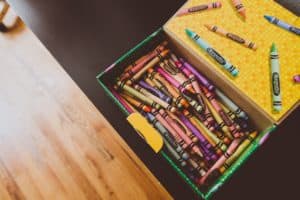
QUICK FACTS
- Many school supplies are non-toxic or low-toxic.
- Keep cold foods cold and hot foods hot in school lunch boxes.
- It takes about 20 seconds for hand sanitizer to be properly applied to dry to hands.
- Make sure you program the Poison Help number into your phone: 1-800-222-1222
BACK TO SCHOOL SAFETY
The long, lazy days of summer are coming to an end and we are getting ready to send our kids back to school. With that comes new school purchases such as markers, paints, glue, lunch boxes, and backpacks. According to the National Retail Federation, parents with school children this fall will be spending approximately $634.78 per student! With all these expenses, we don’t want to add an unnecessary medical expense to the picture, so it’s important to understand the fundamentals of back to school poison safety.
SCHOOL SUPPLIES
Most back to school lists include the basics like, pens, pencils, markers, glue sticks, and other art products. These products are some of the most common exposures that poison centers see in schools. Perhaps a kindergartener paints their tongue with watercolors or a second grader uses a glue stick like Chapstick. Or maybe it is a middle schooler chewing on a pen that breaks open into their mouth. The good news is most of these supplies are considered non-toxic or low-risk and would only cause minor symptoms following an exposure. If you suspect a student has had an exposure to one of their school supplies and you would like additional information, please contact one of our specially trained nurses or pharmacists for more information on the Poison Help line at: 1-800-222-1222.
LUNCH BOXES
Lunch boxes have come a long way from the hard metal boxes of yesteryear. Today they can be canvas, plastic, recycled, insulated, and covered with any character or print imaginable. To keep your student safe, it is important to follow these lunch box safety tips:

• Wash hands thoroughly for at least 20 seconds with soap and water before preparing or eating lunch.
• Keep your student’s lunchbox clean and free from unwanted bacteria by washing it regularly with soap and water and drying it with a microfiber cloth.
• Keep cold foods, such as lunchmeat sandwiches and yogurt, at the proper temperature with a chilled freezer pack. These cold items are only safe at room temperature for 2 hours. The U.S. Department of Agriculture (USDA) recommends using at least two freezer packs to make sure that food stays adequately chilled.
• Make sure hot foods, like soup or macaroni and cheese, stay hot by sending them to school in a tightly sealed insulated thermos.
• Throw away leftovers such as uneaten halves of sandwiches or unfinished soup, as it likely did not maintain a proper temperature until the final school bell.
• Many new lunch boxes, book bags, and shoe boxes contain a small desiccant packet called silica gel that is meant to keep things dry. Silica gel is non-toxic so it will not make your child sick, but can be a choking hazard. Don’t forget to remove these from new packages and items.
SANITIZERS AND DISINFECTANTS
We all know that schools do their best to prevent germs and illness from spreading by using cleaners, disinfectants, and sanitizers. The uses of these products are vital to keeping our kids healthy and germ-free, but can make accidental poisonings a problem.

Hand Sanitizer
Classrooms often have large pump bottles of hand sanitizer and children’s backpacks have small travel-size hand sanitizer as an attachment. It is important for parents to teach proper use of these products as they contain alcohol and can be irritating to children if used improperly. To safely use, put a dollop of the hand sanitizer into the palm of the hand and rub them together until they feel dry, which is about 20 seconds.
Cleaning, Sanitizing and Disinfecting
There’s actually a difference between these three terms. Cleaning removes germs and dirt from surfaces, but does not necessarily kill germs. Disinfecting works by using chemicals that kill germs after cleaning. Sanitizing lowers the number of germs to a safe level and can be done by cleaning or disinfecting, depending on the process. Actual disinfectants should never be used on surfaces that come into direct contact with food. Some products, like sanitizers, can be used in this way, but it is important to follow package guidelines. Products such as cleaners, disinfecting wipes, and alcohol based hand sanitizers need to be kept up, away, and out of sight of children in their original containers. Review the label before each use and follow the instructions closely.
For any questions or concerns about back to school poison safety, call the Poison Help line at 1-800-222-1222. Specially trained nurses and pharmacists are available 24/7/365 to answer your questions. The service is free and confidential.
